#collapse of russian empire
Text
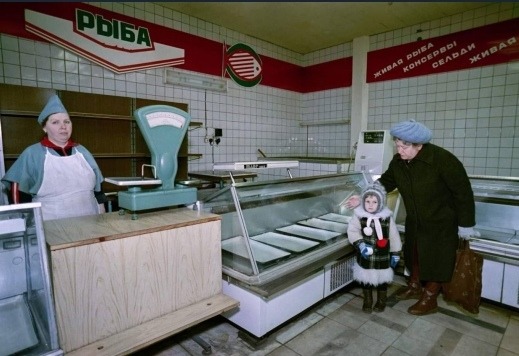
The real socialism, created not by theoreticians and stupid populists, but by communists, looked like this - empty shops and poor residents, while "leaders" enjoyed the benefits created by "capitalists" in special stores: The uniqueness of this photo is that it shows not only a "happy" Russian past, but also their "bright" future towards empty shops and mass poverty... Soviet Union, after WWII (sometime after WWII, a Russian store could look so empty both in the 1950s and just as well in the 1980s)
P.S. No matter how ridiculous it is, there have always been quite a lot of political idiots useful to the Kremlin in the West, who believe that they should befriend with Moscow...In the modern West, the role of this useful idiots has been taken on by various not only left-wing socialists and communists, but also by right-wing and ultra-right-wing foolish populists...
#russia#russian world#socialism#russian imperialism#communism#collapse of the soviet union#collapse of russian empire#european history#useful idiots#populists
47 notes
·
View notes
Text




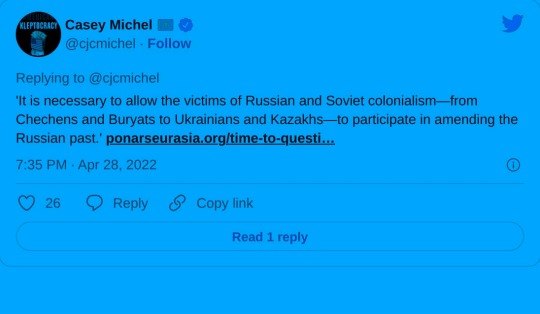
#inevitable collapse of the soviet union#autonomous republics within russia declared sovereignty#russian imperialism#russian colonialism#russia : the last feudal empire#stop russian invasion#i stand against soviet/russian imperialism#ukraine resistance#putin war criminal#ukraine war#slava ukraini#i stand with ukraine
26 notes
·
View notes
Text
With the sudden collapse of the Soviet Union in the early 1990s, many of the former empire's resources were sold off to the highest bidder, and their $14 billion space shuttle program was no exception.
Seeking to recoup some of that eyewatering spend, in 1998, the "Buran" (Russia's answer to the American Space Shuttle) was offered up for sale on eBay for $10 million.
No serious offers were received - with most people assuming the listing to be a joke, until the New York Post confirmed the sale, with Russian authorities stating they "actually have two" if anyone is interested.

(Pictured: A later auction of a smaller scale Buran in 2005)
Sensing an opportunity, a group of Aussie entrepreneurs including Australia's first astronaut and the lawyer for Prime Minister Paul Keating offer to lease the shuttle from Russia, to put it on display in Australia during the Sydney Olympics.
After gaining permission from the Kremlin for the lease, in 1999 the Russian military briefly stops bombing Chechnya in order to dismantle the Buran, and it is placed on a barge to be shipped to Sydney on the (soon to be infamous for other reasons) Tampa shipping vessel at a cost of $5 million.
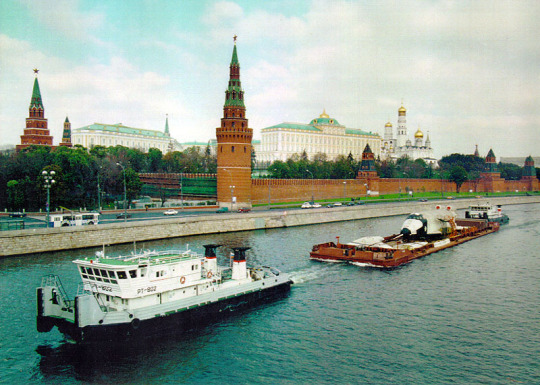
Once in Sydney, after a disastrous few months on display where crowds failed to flock to the shuttle exhibition featuring such compelling educational offerings as "activities is to assist in the development of issues of nutrition and hygiene at home" (an actual quote from their website) - the leasing company declared bankruptcy and washed their hands of the space shuttle completely.

The Buran Gift shop where you could buy soviet space ship themed football jerseys, in case you needed one of those
One of four people listed on the lease, described as a business partner of the Prime Minister, also claims he never knew he was a director of the company, which went on to cause a lot more problems.
This whole debacle presented a slight issue for the cash strapped Russian authorities, who had now only been paid $100,000 for the 9 year lease of the shuttle instead of the $600,000 they were owed. Eventually the decision was made to abandon the once $1 billion Soviet pride and joy in a Sydney carpark, where it resided for a year under a small tarpaulin.
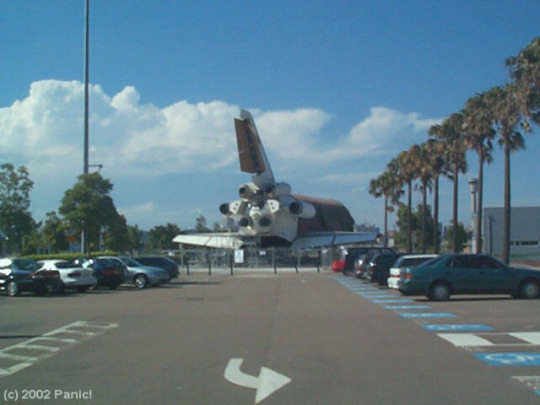
Failed attempts to be rid of the shuttle included a 12 day auction hosted by an LA radio station, where listeners were offered the chance to buy the shuttle for $6 million, however all bids turned out to be pranks and the shuttle remained.
Multiple attempts were also made to sell the shuttle to Tom Cruise, with the exacerbated movie star's representatives repeatedly telling the insistent traders that he was not interested in owning a Russian spaceship.
Eventually a Singaporean group dismantled the shuttle and shipped it overseas, however Russian authorities soon reported they once again had been failed to be paid for the lease. Singaporean representatives responded that they definitely had paid for the shuttle, and that they simply couldn't remember when or how much was paid.
Representing the Russian government, Lawyer Suhaila Turani told the Wall Street Journal “I feel sorry for the Russians. They’re good in space, but they’re very naive in business.”
For a time the shuttle was abandoned in the storage yard of event company Pico, with the company owner telling the Wall Street Journal "I just want this thing out of my life" after three years of being stuck with it.
A few years later the shuttle was found by German journalists dismantled in a junkyard, and it was then bought and shipped to Germany to be put on display a museum, so all's well that ends well (except they dropped it from a crane while trying to set it up, but it polished up okay).

7K notes
·
View notes
Text
"... Last time it was five years between the Titanic disaster and the collapse of the Russian Empire. Really speedrunning this time..."
2K notes
·
View notes
Text
In the aftermath of Prigozhin’s media empire collapse, former employees spoke out about the dark tactics employed, including hiring individuals to portray “victims of Ukrainian Armed Forces” in staged reports that underpinned Russia’s fake pretext for the full-scale invasion of Ukraine — its Big Lie about alleged “genocide in Donbas.”

Following the unsuccessful mutiny of the Wagner Private Military Company, its financier Evgeny Prigozhin had closed down his media empire, including the infamous troll factory. This included Prigozhin’s media holding “Patriot” and such media outlets as RIA FAN, Politics Today, Economics Today, Nevskiye Novosti, and Narodniye Novosti.
Employees of the Prigozhin media were long unable to disclose the state of affairs in the editorial offices, as they were all forced to sign non-disclosure agreements. However, now, they speak. Russian media website Bumaga interviewed several former employees of “Patriot,” who revealed unknown details about its operation and propaganda tactics.
Notably, one RIA FAN journalist who worked with military coverage from Donbas told that the source files of the interview often contained off-screen instructions for the heroes of the reports, who were hired people coached by an off-camera operator who offered advice on how to say their pre-memorized lines more realistically (and with more propaganda effect):
“Most of the people who were portrayed in such stories as ‘victims’ of the Armed Forces of Ukraine were stand-ins, hired individuals. These characters repeated pre-memorized lines to themselves, trying to ‘squeeze out a tear.’ They were also instructed off-camera by the operator to speak ‘slower’ or to ‘repeat this moment again’,” told the former employee of RIA FAN.
This admission is crucial, as it offers more proof of how Russia fabricated its 9-year-long propaganda narrative about the Ukrainian “Nazis” deliberately attacking the “people of Donbas.”
Other famous debunked examples of this narrative included a story that state TV channel Pervyi Kanal ran on 12 July 2014, showing an “interview” with a woman who claimed to have witnessed the crucifixion of a three-year child by Ukrainian nationalists. However, bloggers and journalists from Ukraine and Russia could quickly prove that the woman was an actor and the story was a hoax.
Another well-known debunked “Donbas genocide” propaganda case happened in April 2015. The Russian TV channel NTV claimed that a ten-year-old girl had been killed by Ukrainian government forces in eastern Ukraine, echoing the disinformation story about the crucified boy from the year before. A BBC reporter working on the ground in the conflict managed to prove that also this story was a hoax. (For more examples of Russian propaganda that demonizes Ukrainians, check out our article A guide to Russian propaganda. Part 1: Propaganda prepares Russia for war).
Since Russia first invaded Ukraine in 2014 and occupied part of eastern Ukraine’s Donbas, Russian propaganda has meticulously demonized Ukraine and the Ukrainian Army. One of the grand narratives of its propaganda claimed that the Ukrainian forces attempting to liberate their lands from the Russian invaders were actually “punishing” the Ukrainians in occupied Donbas for their alleged “choice” to be with Russia, which is how Russia called its fake “referenda” that led to the creation of two puppet republics, the Luhansk and Donetsk “People’s Republics.” The revelation from Prigozhin’s media empire’s employees reveals how this narrative was forged, one fake report played by actors after the other.
The final result was the creation of Russia’s Big Lie, the alleged “Donbas genocide,” which Putin used to launch an invasion of Ukraine on 24 February 2022.
Bumaga’s material revealed other fascinating details about the operations of Prigozhin’s media empire.
Former “Patriot” employees revealed the security checks and the workplace atmosphere to Bumaga anonymously. According to a former employee, each media was allocated a floor, and smaller editorials sat together.
“They did not check me on a polygraph, but I heard stories from newcomers. They were taken to a room where security service specialists worked with them and asked questions,” said the source.
These questions, asked during a “lie detector” test, intended to weed out any drug addicts or Russian opposition sympathizers, especially fans of Alexei Navalny, another source told Bumaga.
Moreover, the media empire had extensive surveillance measures in place. An anonymous source disclosed that they “followed electronic passes, cameras, and all records from computer screens were broadcast to the security service.” When Patriot was just opened, a special department existed in the holding that was engaged in custom materials about the opposition.
Two former employees of the Patriot holding, in a conversation with Bumaga, claimed that everyone at the “troll factory” knew that the goal of Evgeny Prigozhin’s media was to create informational noise to “clog the agenda.”
“Information noise was generated along with the implementation of Prigozhin’s interests. While some [journalists] distracted people with the problems of other countries, with these reports from Africa and so on, with our local celebrities and reviews of dumb movies, others, on the front lines, were brainwashing people with materials from the ‘Special Operation Zone‘,” a former journalist of RIA FAN told, referring to Russia’s codename for its invasion of Ukraine, where Prigozhin’s Wagner PMC played a key role.
Now, the former employees of Prigozhin’s once-famed “troll factory,” who sowed disinformation in Russia and abroad, are left without a job. Luckily for them, prominent Russian media managers are stepping in to give them decent work in top Russian outlets:
“Dmitry Sherikh, the head of the St. Petersburg branch of the Russian Union of Journalists, has volunteered to help the employees of the ‘Troll Factory’ find jobs: ‘The Russian Union of Journalists will, whenever possible, appeal to the heads of other media outlets to help find employment for our dismissed colleagues, as well as provide other information support.’ The chief editor of ‘Moskovsky Komsomolets in Petersburg,’ Timofey Shabarshin, who is also the former head of ‘Nevsky News’ (up until 2021), also agreed to welcome the colleagues.
Vladimir Yagudaev [an SMM manager from Prigozhin’s media empire who talked with Bumaga – Ed.] does not know if the Union of Journalists helped his former colleagues, but he notes: ‘Certain chief editors have begun to hire the most interesting employees into St. Petersburg publications. However, this is a limited contingent.'”
Located near St. Petersburg, Prigozhin’s troll factory, also known as Internet Research Agency (IRA), was one of the more-studied elements of the Russian propaganda machine. To achieve its goals, the troll factory employed fake accounts registered on major social networks, online media sites, and video hosting services. It expanded threefold in 2018. The troll factory’s employees were given messages they should push in social media and online debates in what a US indictment called “activities as a strategic communications campaign with an emphasis on target group awareness.”
#ukraine#russia#war in ukraine#russo ukrainian war#russian propaganda#all the major tankies have me blocked someone rub their faces into this thx
301 notes
·
View notes
Text
My next post in support of Ukraine is:
Next site, the city of Kamianets-Podilskyi (Кам'янець-Подільський) in Khmelnytskyi Oblast. Its name is derived from an Old Slavic word, kamin, which means 'stone' and from the historic region known as Podilia. The literal meaning of the name is 'The Stones of Podilia.' It's believed by some historians that there was an earlier city built on the same spot by the Dacians, an ancient people from what is now Romania, Moldova, and parts of Ukraine. The earliest mention of the current city is from 1062. In 1241, it was destroyed by the Mongols. In 1352, it came under Polish rule. The castle in the city (which I posted about earlier in the🧵) was expanded by the Polish kings to guard against the Ottoman & Tatar invasions. Though, in 1672, the city did become part of the Ottoman Empire for a short while. It was returned to Polish rule in 1699. In 1793, after the Second Partition of Poland, the city became part of the "russian" empire. During WWI, it was occupied by Austria-Hungary in 1915. When the "russian" empire collapsed in 1917, it came under the control of the Ukrainian People's Republic and was chosen as its capital when Kyiv was captured by the Bolsheviks. In 1921, it came under the control of the soviet union until 1991, when Ukraine declared its independence.
#StandWithUkraine
#СлаваУкраїні 🇺🇦🌻
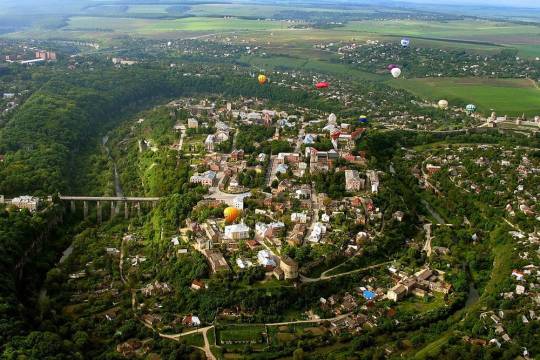
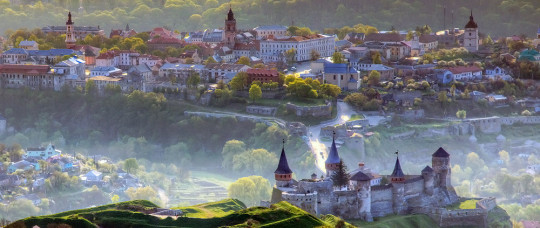
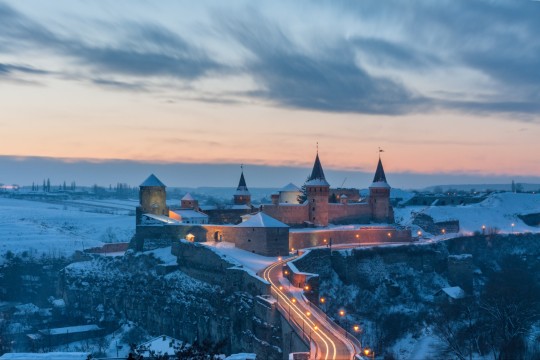
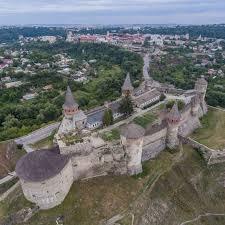
63 notes
·
View notes
Text
He didn’t have to go. In August 2020, Russian dissident Alexei Navalny had been poisoned, probably at the direction of Russian president Vladimir Putin, who saw in Navalny one of the vanishingly few legitimate threats to his reign.
Navalny went to Germany to recuperate. While there, he managed to confirm that the poisoning had been carried out by Russian security services by calling one of his would-be executioners and pretending to be a fellow Kremlin goon. Mother Russia wanted one of her own sons dead.
So why return? “It was never a question of whether to return or not,” he wrote in a social media post in Jan. 2021. Several days later, he landed at Moscow’s Vnukovo Airport, where he was greeted by admirers.
We Russians in the West admired him, too. I saw in his return a refutation of the argument that all Russians wanted was Louis Vuitton boutiques—freedom and democracy be damned. He came back to remind us, whether we were in Brooklyn or Kaliningrad, that we were better than that. Or that we could be, in any case.
Navalny was promptly arrested on entirely fictitious fraud charges that were intended to keep him sitting comfortably at some Washington or Berlin think tank, no threat at all to the Stalinist project underway in Moscow.
He wasn’t supposed to come back. Only he didn’t get the message.
He would never see freedom again. An obeisant court found him guilty, then tacked on “extremism” charges for good measure. “They really do initiate a new criminal case against me every three months. Rarely does an inmate confined to a solitary cell for over a year have such a vibrant social and political existence,” he said in a typically sarcastic social media post conveyed via his representatives.
Navalny became a cause célèbre, one of the few figures within Russia we Russians could be proud of. In arguing that we were better than the country shelling Ukrainian innocents, we could always point to Navalny, even as he looked increasingly gaunt in the video footage made available by his jailers.
There, look at him. As long as Navalny lives, there is a hope of a better Russia. As long as he lives.
Finally, they did what so many of us always feared they were going to do. On Friday, Navalny died at the IK-3 penal colony in Kharp, a remote Siberian village. He apparently collapsed after a walk. He had been in poor health for many months, as he moved from one penal colony to another, suffering prolonged stretches of isolation and other privations.
I grew up in the same country as Navalny: the faded Soviet Union of the 1980s. The desperation of those years, and the chaos of the 1990s, drove many Russians (including my own family) to the West. Some of those who stayed only did so because they figured they could get rich. A seller of blue jeans could suddenly become a copper magnate, as long as he could survive the mafia hits that came with a regular cadence in Moscow and St. Petersburg throughout the go-go Yeltsin years.
An attorney by training, Navalny did not stay to get rich. He stayed for the same reason that would see him return in 2021. He truly believed in Russia, in the possibility of a democratic nation rising from the ruins of the Soviet empire.
Only that wasn’t the country that took shape. “I can’t stop myself from fiercely, wildly hating those who sold, pissed away, and squandered the historical chance that our country had in the early nineties,” he would later say.
Having never won an election, Putin emerged in 1999 to replace the inept and inebriated Yeltsin. He quickly arrogated every means of power, even as Western leaders like George W. Bush foolishly insisted that he was committed to democracy.
I returned to Russia for the first time in more than two decades in 2003. The country looked almost Western: Western-ish. I was impressed. The erosion of democracy, already underway, seemed like a small price to pay for upscale beer gardens where there had once stood drab cafeterias.
Then the price rose. In 2006, the investigative journalist Anna Politkovskaya was murdered for reporting on the brutality of Putin’s campaign to pacify the restive republic of Chechnya, as well as his repressions targeting every segment of Russian society. Politkovskaya saw clearly what was happening. "Who can say,” she wondered, “we are not returning to Stalinist ways under Putin?"
Navalny refused to let it pass.
If some in the West had had a too sunny view of Russia, as if it were nothing but a Harvard Business School case study in unfettered capitalism, there were others who grumbled that Russians were “incapable” of democracy, that something in the Russian spirit required iron-fisted leadership. But whether you believed in the market or the czar, both of these views deprived Russians of dignity and self-determination. We were always to be subject to greater forces wielded by larger-than-life figures, whether Mickey Mouse or Vladimir Putin. It was never our call.
Disenchanted by the cowardice of most Russians with any cultural or political influence, Navalny had, by the end of Putin’s first decade in power, become a full-blown dissident. He started blogging in 2008, then moved towards pure political agitation. It was a dangerous occupation: like Politkovskaya, most critics of the regime were murdered or, if they were lucky, chased out of Russia. “He’s taunting really big people and he’s doing it in an open way and showing them that he’s not afraid. In this country, people like that get crushed,” one Russian official worried to The New Yorker in March 2011.
In Dec. 2011, Navalny was arrested for calling into question the results of a sham parliamentary election. The West took increasing notice. The New York Times pointed to his “Nordic good looks” and “serene confidence,” observing that what “attracts people to Mr. Navalny is not ideology, but the confident challenge he mounts to the system.” He went to jail for the first time, for 15 days.
An authoritarian system always knows how to shore up its weakness. After a brief interregnum during which Dmitry Medvedev pretended to play the role of president, Putin returned to power seemingly determined to never cede it again. Since the 2012 election, he has sat unchallenged in the Kremlin. It is widely assumed that he will remain there until death.
Navalny was virtually alone in trying seriously to dislodge him, challenging Putin for the presidency in 2018 only to see his bid disqualified on invented legalities. “The process in which we are called to participate is not a real election,” he said.
By this point, many of us Russians in the diaspora had come to realize that no number of Moscow skyscrapers could disguise the fact that Putin had turned Russia into a gaudy embarrassment, a country that ran on petroleum and propaganda and aligned itself with Syria and Iran. The invasion of Ukraine shattered all remaining illusions.
It was to this Russia that Navalny returned. Soviet history is rich with artists, intellectuals, and scientists who refused to stay silent in the face of state-sanctioned atrocities. Anyone who grew up in the Soviet Union knows their names: Akhmatova, Sakharov, Sharansky. Navalny reminded us of this tradition, of the eternal need to rouse the people of this huge, complicated country, whose day-to-day lives can be so grindingly difficult that it is hard to think of anything but survival.
Navalny believed in ordinary Russians, in their desire for something more than the material comforts bought by Putin’s petrodollars. That is what he came back to. That is what he died for.
Today, a Russia free of Putin and Putinism seems almost impossible to imagine. But for the sake of Navalny, we must imagine it.
“My greatest hope for Russia is that dictatorships always appear solid until suddenly they aren’t,” Uriel Epshtein, chief executive of the Renew Democracy Initiative—who traveled frequently as a child to Russia, where his family is from—told me. “Putin may feel untouchable today, but he can still be proven wrong. At a certain point, some part of Russian society will decide that they can no longer live under his yoke.”
72 notes
·
View notes
Text


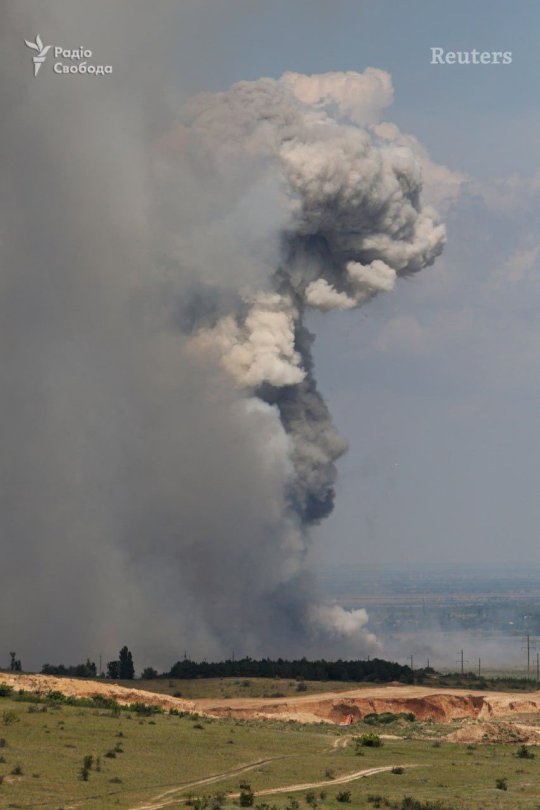
Couple of days ago, Reuters also publishes photos of huge explosions after very successful Ukrainian attack at Russian military training ground in occupied Crimea, Ukraine, July, 2023. Source: Special Kherson Cat
#Ukraine#russian invasion#russian defeat#explosion#conflagration#ammunition#collapse of russian empire#rural landscape#ukrainian independence war#military history
28 notes
·
View notes
Text
if anybody abroad is reluctant to reexamine their relationship to russian culture/literature/etc they should consider that here in ukraine/eastern europe many more people were raised surrounded by much more russian art (in the og language at that). if a dostoyevsky novel has some emotional significance to you that renders it above the current political agenda imagine how much closer the same novel has been, used to be, to many of us
because you know, the saddest thing about russification is that it works. like, all the "they made me read it in high school and i hated it" talk aside, we didn't actually jump out of our mothers' respective wombs with an inherent dislike for russian things. even in the post-independence generation, many (including me) were very late to radicalize, many (including me) used to appreciate the great russian novel, the great russian cinema, the great russian music etc – let alone the generations of our parents and grandparents, who grew up before the iron curtain collapse and had barely anything BUT russian media to bond with.
and hey, nostalgia is a bitch. it gets especially bitchy in a traumatic situation that makes you yearn for the comfort of a "simpler" past. my father still listens to the russian 80s music. sometimes he turns to me randomly and sighs, "that one singer/actor/tv celebrity really turned out to be an asshole, huh."
(fascist. by "asshole" he means fascist)
i used to love bulgakov! because my parents love bulgakov and i love my parents, because i vibed with his style, because i thought "surely his imperialist mindset is obsolete by now, surely whoever likes bulgakov in russia likes him for everything but the imperialism". i used to love "the idiot" because i was a sad christian queer teen and for an ardent nationalist/racist/antisemite/etc, dostoyevsky actually had much compassion for the victim, which appealed to me – i didn't really think that i would be the sort of victim he had no regard for. the indie folk songs that used to be the jam of my soul were written by people who either supported the war or didn't really care, and my first ocs that i still cling to were (originally) heavily inspired by that one godawful copaganda wagner yaoi comic series (which has since been made into a movie, which is now on netflix, yay). russian culture past and modern has left a trace in me that will not go anywhere no matter my current worldview (which is far from sympathetic to russia, i promise) and my future choices.
but there is no floating island in the sky where art is divorced from physical reality. there is no magical place where there is no red string going from dostoyevsky all the way to putin. there is no just space where ukrainian voices are on equal footing with russian voices – precisely because the russian state has been so carefully nurturing the brand of Russian Art (even though some of the artists were killed by the previous incarnations of that same state, even though some artists never identified as russian but had that label forced onto them because an empire will take whatever it can from a colony).
the things that i used to love turned out to be cogs in the weapon meant to kill me. those cogs are still spinning, and i still miss that love sometimes, and there's no going back. it's an uneasy predicament that i had to learn to live with. i didn't die from that. the cogs didn't die from that. you won't, either.
109 notes
·
View notes
Text
• 𝐓𝐡𝐞 𝐅𝐢𝐫𝐬𝐭 𝐖𝐨𝐫𝐥𝐝 𝐖𝐚𝐫 •
The First World War accelerated the path to modernity. It was the "Primal catastrophe" of the 20th century, an era of war, violence and displacement. It cost the lives of around 17 million soldiers and civilians, destroyed large parts of Europe and left behind unresolved problems that led to further violent conflicts.
[Without the First World War, the rise of fascism and communism and the transition to systemic competition between West and East, the 20th century cannot be understood.]
The assassination of the Austro-Hungarian heir Franz Ferdinand and his wife in Sarajevo on June 28, 1914 is regarded as the trigger for the First World War. In Vienna, the military pressed for a swift retaliatory strike against Serbia. The German Reich assured Austria-Hungary of its unrestricted loyalty to the Danube monarchy.
On July 28: Austria-Hungary declares war on Serbia - Russia starts mobilization.
On August 1: The German Empire declares war on the Russian Empire.
August 2: Invasion of German troops in Luxembourg.
August 3: Invasion of German Troops in Belgium - the First World War begins.
The age of weapons of mass destruction and industrial warfare began in early 1915 with the German chlorine gas attack on the Ypernbogen. Almost two million German, French and British soldiers died on the barren battlefields and in the trenches of the "Hell of Verdun" in 1916. However, the course of the front changed only slightly as a result of these material battles.
In total, the war claimed 17 million lives. It ended on November 11, 1918 with an armistice and the defeat of the German Reich. In Germany, the monarchy collapsed and the Weimar Republic was founded.
In 1917/1918, numerous monarchies collapsed in quick succession and were replaced by democratic republics, as was the case in Germany in November 1918.
After 1918, no new stable framework of order was recognizable - neither socially, politically nor internationally.
The new models of the Russian Bolsheviks, the fascists in Italy and the National Socialists in Germany were unmistakably opposed to the liberal legacy of the 19th century, not least in their pronounced willingness to use violence. This had to do with the diverse experiences of world war, the transitions from state war to revolution and civil war, as well as the disappointed expectations in many societies in view of the peace treaties of 1919.
#german history#history#teaching#studyblr#studying#booklr#books#literature#I will teach you history on a creative way not the boring teacher way#aestetictumblr#germany#italy#russia#history is important#world war#world war ii#world war 1#20th century#19th century#political#politics#study blog#study motivation#I Love studying lmao unpopular opinion#I’m new on Tumblr#spread knowledge#knowledge#I want to know everything like Faust#important history#historical facts
48 notes
·
View notes
Text
So I was on a panel about cyberwarfare as it relates to the Russian invasion of Ukraine back in December 2022 and afterwards while talking to some people said that the boldest statement I was willing to put money on was that we were closer to the end of the war in Ukraine than to the start of it and that Russia would fail and collapse sooner than people thought, just like the Soviet Union where people were blindsided by the collapse.
I pointed out that there’s fractures everywhere in their front that entirely relied on plugging by throwing untrained bodies at the problem, which would inevitably be unpopular at home. That besides the size of their force, Russia was completely outclassed. That they’d expected an easy fight and got blindsided. That corruption had gutted their effectiveness to the tune of billions in money stolen by the oligarchs. We couldn’t say when it would all fall apart but the West was still buying into Russian propaganda to continue to see strength where there was nothing but floundering and weakness propped up by brutality.
I pointed out that just about every objective that Ukraine claimed it would achieve, they had, and nearly every objective Russia had claimed they would achieve they’d failed at, and eventually those would add up and to stop thinking there was some deeper clever play at work. That they were in a shit ton of trouble, the question was just when it would all come crashing down.
And it was a bold thing to say! Possibly naive! It might still be naive if Wagner really does achieve their goals and do as they promised and turn around and go back to the front. But that seems a long shot only from the sheer internal disarray caused by them abandoning it. I can’t imagine those soldiers are going to want to go back. The parallels to the Bolsheviks is jaw dropping that Russia would again put all their political dissidents in prison, then recruit from prisons for a war, thus giving all their political enemies military training and cohesion.
I also can’t help but think that the Wagner leader saw this was the best chance he’d ever have to seize power with the experienced army at his disposal and with threat of assassination looming over him he was basically given Caesar’s choice and had to cross to the Rubicon or die.
But anyway. There’s still no way of knowing how this plays out. This is a truly chaotic situation reminiscent of the days of Rome’s Soldier Emperors or Machiavelli’s warring Italian cities, when the man with the biggest, most effective army could take over empires if he moved cleverly enough, or combust spectacularly in the attempt. It’s truly mind boggling to behold in the modern era with such a major state.
My greatest hope is that this proves enough for Ukraine to achieve a decisive victory and regain all its territory while Russia is distracted.
And, I admit, I’m feeling a little vindicated right now after saying this to a room of people who had largely bought into Russia’s claims about its own power. These current events are not things that happen to a successful, stable world power.
115 notes
·
View notes
Text
Current worlds I'm building on my head:
Biopunk South America: where a biotechnology revolution and a worldwide ecocide changed the world forever, set in Buenos Aires in 2143. Six students set to make a grant project that would bring back the spirit of old biopunk. Inspired by Argentine rock and fútbol, hacker culture, and biopunk of course.
Campoestela: A 'classic' space opera setting, humanity has spread across the stars meeting hundreds of other civilizations, the focus here is on the cultural diversity of countless worlds. An Argentine space trucker finds a cringefail gamer girl from an extinct civilization and they try to cope with this. The theme is travelling but not for adventure but to work, like truckers or bush pilots.
The Alchemists: Set in the historical Republic of Florence in 1491, except the supernatural is very, very real. An alchemist and a witch deal with adolescence and their jobs while uncovering the secrets of Hermes Trismegistus (and eventually travel all the way to Egypt, China and beyond). A magical setting but based, as much as I can, in real historical conceptions of 'magic'.
Space Battleship Aurora: During the twilight years of the Space Roman Empire, the crew of a battleship rebel and they join a communist (not metaphorical, literal) revolution, as things fall apart. Basically a retelling of the Russian Civil War but in fantasy space.
METAL LML: This is just a rule of cool setting where everything that happens in Heavy Metal covers (the magazine and the genre) is real. A bunch of badass characters fly on their spaceship fighting hordes of evil demons with the power of METAL. With a found family, if you actually care about plot or stuff like that.
Argentina post-magiapocalíptica: Somewhere in 2012, the world changed and civilization collapsed with the "return" of magic. Argentina is a vast land full of wonders, all based in popular legends from the pre-columbian to current memes. Argentina-core basically. It has a lobizón and bruja characters too.
América Invicta: In this setting, the Inca and Mesoamerica remain unconquered, but they still have to deal with the contact of Europeans. This is a setting where every myth and legend about the Americas is real and then some. It's an excuse to present more Latin American mythology and legend.
The Greatest Scam: A hard (as it can be) sci-fi setting where the Solar System is turned into a dyson sphere to mine bitcoin, and the Socialist Interstellar roams the galaxy, safeguarding what remains of Earth from the ultimate apotheosis of capitalism
Concordia: (or Star Trek: Rebuild) An optimistic atompunk (but realistic) setting where the US and USSR decided to cooperate and do a joint atomic and space program, and things escalate from there. Humanity reaps the benefits of the peaceful Atomic Age, as ATOMIC ROCKETS explore the stars.
If you see me talking about worldbuilding, or reblogging very specific things, it's about some of these. EL BIOTIPO CINEMATIC UNIVERSE.
#cosas mias#there's also a space gauchos one and another space opera one but I haven't worked on them lately#(by work I mean doing drabbles and imagining stuff)#oh and all the alternate history ones I didn't even mention them#worldbuilding
34 notes
·
View notes
Text
Caribbean cruise vacations have a long violent history. Earlier today, I came across one of the early print advertisement illustrations for the Caribbean cruise ship vacations offered by “the Great White Fleet.” And I pondered bananas.
Just as uncomfortable as it sounds. The story of the origin of the Caribbean cruise industry is, after all, also the story of the origin of the term “Banana Republic.”
In 1914, the Great War began as the planet’s powerful empires of old were collapsing, as British, French, Austro-Hungarian, Ottoman, Russian, and Qing/Chinese powers were marred by internal revolt and global warfare. But in 1914, the United States completed their Panama Canal and consolidated power in Latin America and the Caribbean, celebrating the ascent of a “new” empire made strong, in part, by bananas.



As of 2022, bananas generate 12 billion dollars per year, with 75% of bananas exported from Latin America and the Caribbean.
The planet’s single biggest banana-producing company is Chiquita. The Chiquita brand was previously known as United Fruit Company, which had essentially monopolized the banana industry in Latin America. United Fruit Company has a bit of an image problem, following its theft of Indigenous land across Central America in the early 20th century; its role in provoking the killing of tens of hundreds/thousands of plantation laborers during the Banana Massacre of 1928; the company’s direct role in the CIA-backed toppling of the Guatemala government in the 1950s; and the company’s role in paying to harass and intimidate labor organizers in Colombia in recent decades.
But what of the “romance” and “adventure” of the Caribbean?
So it’s 1915 or 1916.
Middle of the Great War. Classic empires are disintegrating: Spanish empire, British empire, Austro-Hungarian empire, Russian empire, Ottoman empire, remnants of the Qing/Chinese state, etc. And whose empire is rising? United States, an empire expanding in the Caribbean, Central America, and South America. After the 1898 Spanish-US war, as Teddy Roosevelt’s cartoon cavalry conquered Cuba, the Spanish Main belongs to the US of A. The US Navy controlled the Caribbean Sea, and was aiming to expand across the Pacific Ocean, to Hawai’i and beyond.
But the official US Navy isn’t the only fleet upholding the empire. The United Fruit Company had its own fleet.
The text of one of these Great White Fleet ads, from 1916, adorned with imagery of a blue-and-gold macaw and an aerial map of the Caribbean, reads:
“[W]here winter never comes and where the soft trade winds bring renewed health. [W]ith all the comforts and all the luxuries of life you enjoy aboard the palatial ships of the GREAT WHITE FLEET. Delicious meals a la carte [...]. Dainty staterooms, perfectly ventilated [...]. [A]mid the scenes of romance and history in the Caribbean. And with it the opportunity to win for yourself a treasure of health and happiness, of greater benefit than the fabled fountain of youth, sought by Spanish adventurers in the tropic isles of the Spanish Main.”
Who’s leading the charge?
The United Fruit Company!

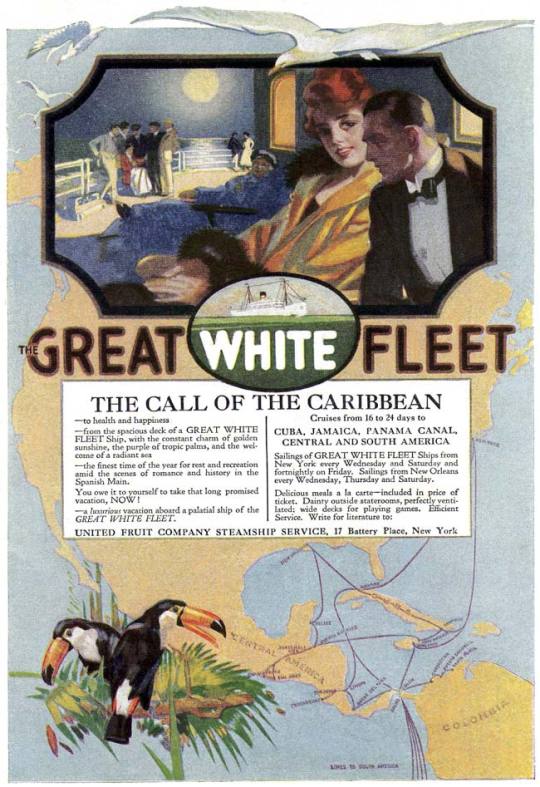
From the May 1916 issue of Red Book. Image source, from Archive dot org:

Another:
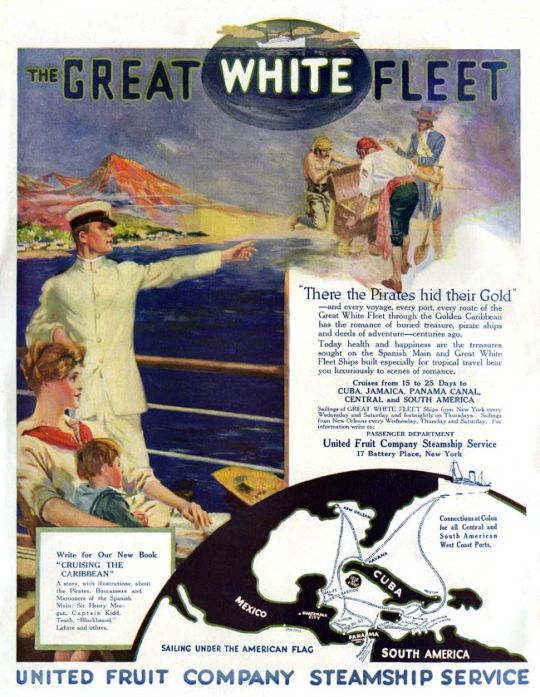
Image source, from Archive dot org:

“There the Pirates hid their Gold -- and every voyage, every port, every route of the Great White Fleet through the Golden Caribbean has the romance of buried treasure, pirate ships an deeds of adventure [...].”
The Golden Caribbean.
The same region where Columbus murdered Indigenous people, where the US and France had just spent 100 years punishing Haiti with unending economic warfare afters slaves rebelled against colonization, and where the United Fruit Company would now set up shop.
The company’s plantations would expand across Central America, establishing brutal racial hierarchies and essentially controlling federal governments of Central American nations.
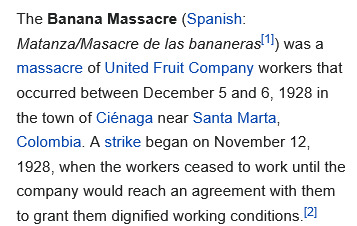
In 1928, over 30,000 laborers were on strike at banana plantations in Colombia. They demanded payment of actual wages, rather than the credits they were given which were mostly only redeemable at company-owned stores in company towns. The US government threatened to send the Marine Corps to intervene if the “subversive” workers would not return to UFC’s plantations. In December 1928, after martial law had been declared, General Cortes Vargas entered the town square of Cienaga (Magdalena) during Sunday gatherings, with machine guns, opening fire on the crowds, and killing perhaps 3,000 people.
In the late 1940s, the United Fruit Company intensified its ad campaigns led by propagandist Edward Bernays (nephew of Sigmund Freud???), who also practiced his skill at manipulative advertising when working to popularize the American Tobacco Company by showing women smoking “torches of freedom” and linking “women’s rights” to cigarette iconography.
Bernays, who explicitly wrote about his “counter-Communist” intention in the ads, was “drafted” in the war to topple ascendant leftist governments. After 1944 and after Arevalo’s labor reforms, Jacobo Arbenz Guzman took control of Guatemala in 1951, and took over 200,000 acres from United Fruit Company and returned them to poor families. Bernays launched propaganda attacks against Guatemala, helping to plant stories about Guatemala eventually carried in the Saturday Evening Post, New York Herald Tribune, and Reader’s Digest. In January 1952, Bernays personally led a tour of Central America, accompanying publishers and editors of Newsweek, the Miami Herald, the San Francisco Chronicle, the Cincinnati Enquirer, Scripps-Howard, and Time magazine. When the CIA-trained military force led by Carlos Castillo Armas invaded Guatemala, with CIA aerial support, installing Castillo Armas as president, Bernays called them an “army of liberation.”

Bananas and Caribbean cruises aren’t the only culprits in expanding imperial power in Latin America, the tropics, and the Global South.
In 1914, the same year that the United States finished the Panama Canal and consolidated power in Latin America and the Caribbean, Richard Strong was a newly appointed director of Harvard’s new Department of Tropical Medicine. Strong was also appointed director of the Laboratories of the Hospitals and of Research Work at United Fruit Company. Strong toured the company’s plantations in Panama, Costa Rica, Guatemala, Honduras, and Cuba. In the coming years, Strong would also personally approach Harvey Firestone, chief executive of the Firestone company, which owned and brutally operated rubber plantations in tropical West Africa. Research in tropical medicine was thus inaugurated by and dependent on colonial/imperial plantations and racial/social hierarchies at United Fruit Company and Firestone sites across the tropical regions, planetwide. Strong is just one character that demonstrates the interconnectedness of academia, fruit plantations, rubber supplies, food distribution, motor vehicle industries, strike-breakers, military forces, imperial expansion, and other tendrils of violently-enforced racist power.
Today, in 2022, Chiquita maintains twenty thousand employees across 70 countries.
I think about this as I eat a banana for lunchtime. I think about this when I see the Edenic portrayal of a Caribbean shore, a landscape baked not so much by the tropical sun but instead scarred by centuries of genocide, slavery, and plantation labor, where government officials gleefully report “with honor” on the massacre of thousands.
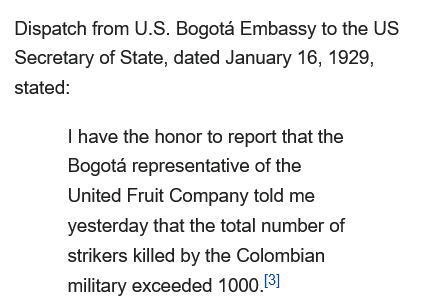

“Just a banana, it ain’t.”
Agreed.
336 notes
·
View notes
Note
Russia will not fall apart. The United States and the European Union will collapse like the Roman Empire, which is mired in debauchery. When the peoples of any country turn into a consumer society without feelings of shame and conscience, they self-destruct.
Where to even begin with this? Should I start with that the Russian state collapsed three times in the 20th century, the Russian Tsardom, the short-lived Russian Provisional Republic, and the Soviet Union? Should I start with the fact that the European Union is not a country and cannot experience national collapse? Should I start with the rates of violence and child exploitation in Russia that tell me that Russia has no business telling other countries that they don't have shame or conscience?
The West *is* decadent though. Even our rural folk have indoor toilets, which isn't something you can say about Russia. It's been a hoot watching the Russian Federation pretend it's a world power while showing off its incompetent army and send its people to slaughter because no one fears it anymore.
-SLAL
25 notes
·
View notes
Note
I kinda doubt there will actually be a civil war or that putin is in any kind of real danger but do you think that maybe prigozhin will be killed? it would at least be sth i guess
I have seen some speculation in various places around the lines that "Putin ordered Prigozhin to do this and Prigozhin is just playing the role of the agent provocateur/setting the stage for another war crime in Ukraine and there's no actual crisis at all." I do not think that's true. They already blew the Kakhova Dam with much less ceremony, and with much less tangible risk to the regime. Likewise, the thing about Russian "provocations" or "false flags" is that they're all lies and don't actually involve any real action, just rhetoric and claims in their information/social media sphere. This also plays into the repeatedly discredited idea that Putin is a "master strategist" and is playing some incomprehensible genius 12-dimensional chess that it's impossible for us to understand, rather than being an aging psychopathic dictator who decided to "reconquer" Ukraine for a) the greed of his rapacious oligarchic inner circle and b) the "messianic militarism"-inspired crusade favored by Alexander Dugin and the other ultra-Orthodox, ultra-nationalist, neo-fascist thinkers who influence Putin the most. It's not actually that complicated.
Likewise, the amount of Russian military activity/attempts to fortify Moscow against an actual siege suggests that whatever Prigozhin is doing, it's not on Putin's orders and is out of Putin's direct control. Putin has given the requisite fiery speech about how Prigozhin is a traitor and he should be destroyed, there are Wagner Group vehicles heading up the M4 motorway to Moscow, anti-terrorism preparations underway in Moscow itself, etc. If you remember the fit they threw when there was one tiny drone above the Kremlin, you can see that they're taking the possibility of an actual attack seriously. If Putin was a master strategist (which he's not), there's no way in hell he would decide on launching an actual, real-world, armed coup against himself as the best way to shore up his power. The Wagner group has been fighting for months, Prigozhin has been blasting the Ministry of Defense for months, and Putin, like any other degenerate Russian dictator increasingly past his sell-by date, fears a coup more than anything else in the world. That's why he keeps hiding in bunkers and using doubles and whatever the fuck else layers of disinformation and misinformation that the regime specializes in. He knows what happened in 1917 and then in 1991 and the collapse of the Russian Empire/Soviet Union as a result. Putin's only aim has been to keep power, no matter what. There's literally no way in hell he would actually run the risk of letting a coup succeed.
Basically: I still don't know what's going on, nobody else does either, and as I said in my last answer, it's a good idea to question everything that comes out of Russia. However, this does absolutely not at all appear to be in Putin's control in any way, and is something he and the establishment are trying desperately to tamp down, because it represents a genuine threat to his power. Also as noted, we're rooting for all of them to bite each other's dicks off and explode. If Putin is still in effective control of the military or the country or anything, he clearly has to give the order to execute/liquidate Prigozhin. If he gives it but can't carry it out, he's no longer in command in reality, regardless of what it says on paper. If he doesn't give it, he's fatally weak and knows the inept regular Russian army of conscripts and criminals can't compete against the battle-hardened Wagnerites, and he's totally dependent on them to continue his insane war. If that's the case, everyone else will also see it too, and things could go very bad for poor old Vladimir Vladimirovich, very fast.
As I said before: Stay tuned.
48 notes
·
View notes